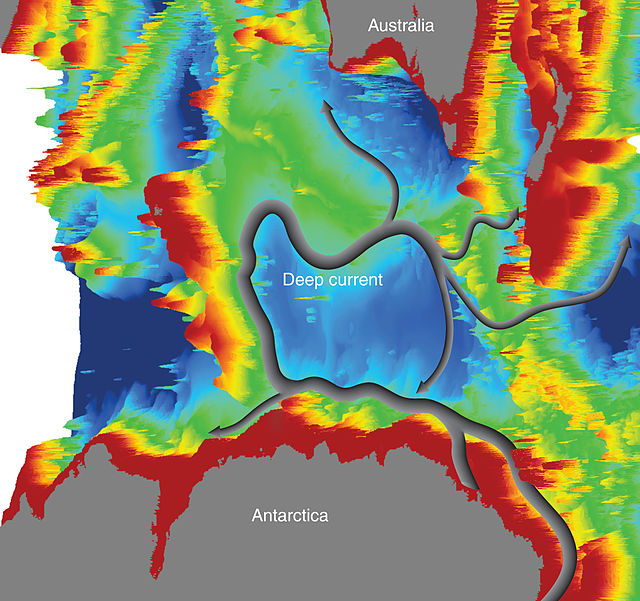Antarctic Circumpolar Current
Antarctic Circumpolar Current (ACC) is an ocean current that flows clockwise from west to east around Antarctica. An alternative name for the ACC is the West Wind Drift. The ACC is the dominant circulation feature of the Southern Ocean and has a mean transport estimated at 100–150 Sverdrups, or possibly even higher, making it the largest ocean current. The current is circumpolar due to the lack of any landmass connecting with Antarctica and this keeps warm ocean waters away from Antarctica, enabling that continent to maintain its huge ice sheet.
The Antarctic Circumpolar Current is the strongest current system in the world oceans and the only ocean current linking all major oceans: the Atlantic, Indian, and Pacific Oceans. Seawater density fronts after Orsi, Whitworth & Nowlin 1995.
The Falkland Current transports nutrient-rich cold waters from the ACC north toward the Brazil–Malvinas Confluence. Phytoplankton chlorophyll concentration are shown in blue (lower concentrations) and yellow (higher concentrations).
An ocean current is a continuous, directed movement of seawater generated by a number of forces acting upon the water, including wind, the Coriolis effect, breaking waves, cabbeling, and temperature and salinity differences. Depth contours, shoreline configurations, and interactions with other currents influence a current's direction and strength. Ocean currents are primarily horizontal water movements.
The bathymetry of the Kerguelen Plateau in the Southern Ocean governs the course of the Kerguelen deep western boundary current, part of the global network of ocean currents.
Coupling data collected by NASA/JPL by several different satellite-borne sensors, researchers have been able to "break through" the ocean's surface to detect "Meddies" – super-salty warm-water eddies that originate in the Mediterranean Sea and then sink more than a half-mile underwater in the Atlantic Ocean. The Meddies are shown in red in this scientific figure.
A recording current meter





